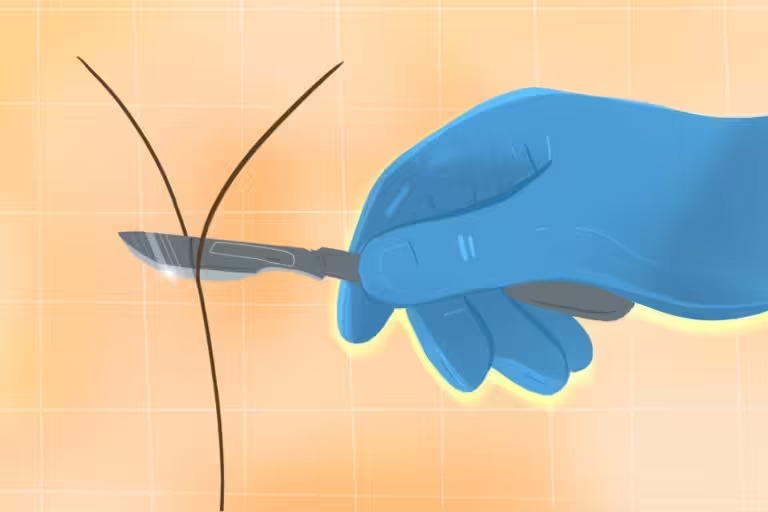
Paying attention to small details
“Academics are often accused of ‘obsessing over the details,'” David Taylor told Feedback magazine. “This year my team and I have managed to do just that. We have built a machine that can literally split a single hair from end to end. This is the first time that anyone has been able to split a hair in a lab in a controlled environment and quantify the phenomenon. Were you planning any exciting beauty treatments like colouring or curling your hair? You’ll have to wait and see if this will cause split ends.”
He and his team documented their adventure in a paper called “The Biomechanics of Hair Splitting.” Interface Focus.
This is based on research done in the 1980s by Y. K. Kamath and H.-D. Weigman, who sought to take a closer look at what happens when a hair splits.
in Journal of Applied Polymer Science Kamath and Weigman, who published a paper titled “Fracture Analysis of Human Hair,” were less excited: they merely stated that “electron microscopic evidence suggests that fracture propagation occurs via secondary cracks generated as a result of accumulated stress concentrations around a primary crack.”
Water from the wreckage
Brazilian researchers have been searching outside the cemetery for the remains of people buried within it. Their main question is whether the decaying bodies are negatively impacting the deep groundwater in the area. Elias Saba and his colleagues have compiled it all in a study with the eerie and geeky title “Assessing the Impact of Cemeteries on Groundwater by Multivariate Analysis.”
The team collected data from three “monitoring wells” dug at the cemetery and compared it with data from the local sewer company about water in nearby household cisterns. Multivariate analysis provided both good and not-so-good news.
The researchers explain that the soil, both inside and outside the cemetery, absorbs most of the problematic waste from the bodies, “preventing surface contaminants from reaching the aquifer.” That’s a good thing. But the problem is that water samples taken in areas outside the cemetery do not meet Brazil’s drinking water standards.
Grandma drinking alcohol
Ancestral water resources are not a new issue. Perhaps the most attention on this issue came in 2008. Journal of Environmental Health.
Reader Russ Hodge sent in a copy of an article titled “Drinking Grandmas: The Problem with Embalming” by attorney Jeremiah Chiapelli and health science professor Ted Chiapelli of Western Carolina University in North Carolina for feedback.
The Chiappellis explain: “Modern embalming involves replacing organic blood with a variety of toxic and carcinogenic chemicals, particularly formaldehyde. The embalmed body is then buried underground, but even when placed in a coffin, bodily fluids inevitably leak into groundwater. The reasons embalming was first undertaken, and the rationale for the continued practice, do not justify the potential public health and environmental risks posed by embalming.”
The Chiappellis also talk about research done by others about why so many people in the U.S. choose embalming: “In states that require funeral directors to be embalming technicians or have embalming facilities, cremation rates have decreased due to funeral director solicitation.”
settlement
Nothing livens up the social atmosphere at a strange pub like axe throwing, but the sport can pose dangers for some of those who approach it in a obliging, professional manner.
According to researchers Kusha Dabar, Arthur Jeng, and Suzanne Donovan, one such risk factor is blastomycosis, a fungal disease that “manifests as a pulmonary disease” but can also affect the skin, bones, and genitourinary tract.
More information (including colorful photographs) is available in the three-person study, “Taking the Axe to Endemic Diagnosis: Disseminated Blastomycosis in Emerging Occupational Exposures.”
The patient “worked at an axe-throwing factory after moving to Los Angeles,” and “his work involved cutting wood for customers.”
Dabber, Jenn and Donovan claim that the disease is “not routinely diagnosed” in Southern California. They say: Blastomyces The fungus was present in the wood before entering the patient’s body.
Telltale Title
Below are two titles recently added to our collection of feedback, “The Title Says All You Need to Know.”
“The effect of wet underwear on thermoregulatory responses and thermal comfort in cold weather” Ergonomics 1994.
And the “pain that may be experienced during different methods of execution” likely surprised readers of the magazine. Sensing 1993.
If you’ve come across similarly impressive examples, please submit them along with citation details to Telltale titles, c/o Feedback.
Marc Abrahams is the founder of the Ig Nobel Prize ceremony and co-founder of the journal Annals of Improbable Research. He previously worked on unusual uses of computers. His website is Impossible.
Do you have a story for feedback?
You can submit articles for Feedback by emailing feedback@newscientist.com. Please include your home address. This week’s and past Feedback can be found on our website.

